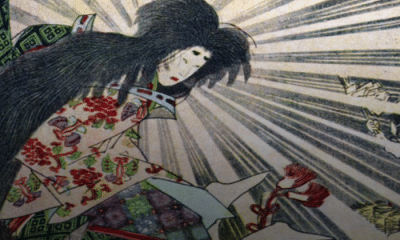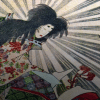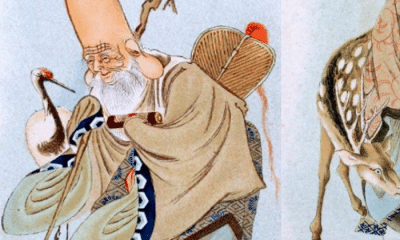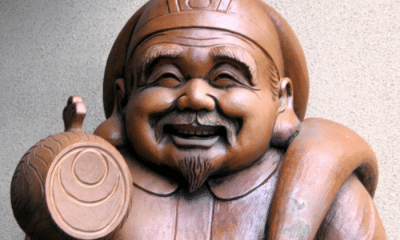Japanese
Kagutsuchi: The Japanese God of Fire
The spirit of fire and volcanoes, Kagutsuchi played an important role in how the Japanese saw their land.
In Shinto, the traditional religion of Japan, thousands of kami are associated with every aspect of the natural world and human life. Many of these are minor and localized spirits, but others were well-known and influential throughout Japan.
One of these major spirits was Kagutsuchi, the god of volcanoes and fire. He was so destructive that his birth killed one of the major creator goddesses, but he was also associated with creation, as well.
Kagutsuchi’s body formed many of the islands’ most prominent volcanic mountains and deities associated with them. His violent fires were followed, both mythologically and in real life, by growth and fertility.
Kagutsuchi is also and example of a world-wide trend among volcanic gods. Although not directly related to one another, he is one of several gods that links volcanoes to metalworking and human invention.
The Birth of Kagutsuchi and the Creation of Mountains
Kagutsuchi was one of the last children born to Izanagi and Izanami, two of the principle creator gods of Shinto.
Izanagi and Izanami were siblings, said in the most widely-known version of the story to be part of the seventh generation of spirits. They were commanded by the Spirits of Heaven to create land.
They created the first land, Onogoroshima, by plunging the Jewelled Spear of Heaven into the sea. On this island, they met at the Mighty Pillar of Heaven in the center and began to create more land.
While Izanami and Izanagi had used the spear to make the first land, they mated with one another to create the lands that appeared afterward. After some misfortune, they created the islands of Japan.
With the islands in place, they gave birth to more spirits. Different versions of the story exist, but Izanagi and Izanami were generally said to have created many spirits of the landscape, rivers, seas, and other natural features.
Finally, Izanami gave birth to Kagutsuchi. The spirit of fire was so hot at birth that Izanami was badly burned and soon died of her injuries.
According to some accounts, Izanami had at least one other child before her death. Mizuhanome, a goddess of water and irrigation, was born in her mother’s death pangs and given instructions for how to pacify her brother if he became uncontrollable.
In other versions of the story it was Haniyasubime who was given this task, as was also said to be Kagutsuchi’s wife. Her name means “Lady Kneeding Clay,” and she was associated with the soil and plant growth.
After Izanami’s death, her partner was furious. Izanagi punished his son harshly for causing his mother’s demise.
Many stories say that Izanagi did everything in his power to bring Izanami back from the dead, but was unable to do so. To avenge her, he killed Kagutsuchi and cut his body into eight pieces.
These pieces were strewn across the lands of Japan, creating eight new mountain spirits. In many tellings, these spirits were associated with volcanoes.
Some versions of the tale also said that eight more spirits were born from Kagutsuchi’s blood. They were spirits of power, lightning, and ravines.
Kagutsuchi was the god of destructive fire, volcanoes, ceramic workers, and smiths. At traditional Shinto shrines throughout Japan he was recognized for both his ability to create and destroy.
My Modern Interpretation
As the spirit of vulcanism, it is understandable that Kagutsuchi would play an important role in Japanese religion and its creation story.
The Japanese islands are mountainous and highly volcanic. In fact, Japan is home to nearly 10% of the world’s active volcanoes.
While Japan’s volcanoes have been relatively quiet in recent decades, eruptions have been a common aspect of the country’s history. Small eruptions happen frequently and larger events have historically occurred at an average of three to four times per century.
Japan’s writing system developed relatively late in comparison to other well-known ancient cultures, with Chinese characters not coming into widespread use until the 5th century AD, but even so there are more documented eruptions in Japanese history than anywhere else in the world.
Living in such a volcanic hotspot, it is understandable that a god of volcanoes and fire would have played an important role in the Shinto religion.
While the early Japanese people did not understand geology as we do today, their mythology also reflects the importance of volcanic activity in creating their landscape.
As in many religions from volcanically-active regions, the volcano god of Japan was associated with fire in general. While the erupting mountains were fire in its most primal sense, the same threat was present in man-made fires as well.
Kagutsuchi also fits a world-wide archetype for volcanic gods in that he was associated with creation as well as destruction.
In most volcanically-active regions of the world, the god of this primal form of fire was also the god of smiths.
Smith gods are common throughout Asia, Europe, and African cultures. They take many forms, but in areas with volcanoes they are typically linked to these mountains.
In Greco-Roman mythology, for example, Hephaestus/Vulcan was the smith god of Mount Olympus and the god of volcanoes. Both Greece and Italy linked him to volcanic mountains within their own countries and, particularly in Rome, protection from fire was a key aspect of his worship.
The Japanese volcano god was not a smith himself, but became the patron of those who used fire in their work. Metalworkers and ceramic artists worked with fire that was, like the interior of a volcano, far hotter than a typical household hearth.
Kagutsuchi and characters like Hephaestus did not develop from a shared archetype. Rather, they represent the ways in which disconnected cultures came to see the same connection between the human world and nature.
Like the Romans, the Japanese included Kagutsuchi in many of their shrines and rituals to both honor him in the act of creation and to protect against his destructive nature.
Representing the dual threat of natural and man-made fire, Kagutsuchi was incorporated into many shrines. He did not, however, directly protect against fire.
In Shinto, there are thousands of kami, or spirits, that represent virtually every aspect of the world. Atago Gongen was the spirit that protected against fire.
There are over nine hundred Atago shrines throughout Japan and imagery of Kagutsuchi was included in many. Often these shrines were placed on mountains, several themselves volcanic, so they could serve as both places of worship and as places to look out for dangerous fires.
In these sites, Kagutsuchi was often associated with Haniyasubime or Mizuhanome. While Atago Gongen could protect against fire, these goddesses could quell it.
The instructions that his sister was given for containing Kagutsuchi were impractical for containing a volcanic eruption, but could be applied by humans to the structural fires that would be common in cities and towns. These included traditional fire fighting techniques such as using wet clay and soaked reeds to smother a fire.
Whether a specific work tied Kagutsuchi to Haniyasubime or Mizuhanome, however, he was still linked to agriculture. Haniyasubime was an earth goddess while Mizahanome was the kami of irrigation.
The ancient Japanese recognized the link between their volcanoes and the rich soil around them. With so many eruptions, observation easily showed that the soil became more fertile in the years following ashfall.
Thus, while Kagutsuchi himself was not an agricultural deity, he was consistently linked to the fertility of the land. Both goddesses associated with him were said to be born just after his own fiery creation, representing the ways in which plant growth flourished after a volcanic eruption.
In Summary
Kagutsuchi was the Shinto kami, or spirit, of fire. He was born to Izanagi and Izanami, the god and goddess who created land.
When he was born, Kagutsuchi’s fires burned Izanami so badly that she died of her injuries. The furious Izanagi killed his son in retailiation, cutting his body into eight pieces.
These pieces were said to have become new mountain spirits, and in some legends the mountains themselves. These were eight of Japan’s most prominent volcanoes, although Kagutsuchi was associated with all of the island chain’s roughly one hundred active sites.
As a volcanic god, Kagutsuchi represented the destructive nature of fire. He was worshiped at many shrines alongside the spirits who protected against such destruction.
Among these were goddesses who were said to have been born as Izanami died. These goddesses were associated with agriculture and had the power to, through practical means, dampen Kagutsuchi’s flames.
He was also the patron spirit of smiths and ceramic workers. In an archetype that developed independently around the world, the Japanese linked the heat of a forge or kiln with the natural heat of the islands’ many active volcanoes.







